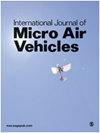高空气球发射微型滑翔机项目:飞行器设计、控制和飞行试验
IF 1.5
4区 工程技术
Q2 ENGINEERING, AEROSPACE
引用次数: 3
摘要
本文介绍了印刷电路板制造的微型滑翔机的设计细节和飞行试验验证。微型滑翔机的目的是从高空的超高压气球上发射,滑翔到目标位置收集数据并将数据上传到停留气球上。任务需求要求微型滑翔机以较小的尺寸和较低的制造成本完成精确着陆。为了完成这一概念,我们设计了一种PCB制造的飞机,其传感器有限,包括GPS和IMU。文章的第一部分介绍了空气动力学设计方法。第二部分介绍了通过控制滚转角和飞行轨迹角来完成精确着陆的控制和制导系统设计。在第三部分给出的模拟结果中,无风条件下的发射显示出理想的精确着陆能力。相反,风向和大小对制导能力和精度有显著影响。最后介绍了在中国内蒙古进行的两次实际飞行试验,将飞行性能与目前的空气动力学和控制系统设计进行了比较。返回的数据表明,微型滑翔机可以成功地在高空飞行。控制算法只能通过GPS和IMU来计算指令滚转角,但为了实现精确着陆能力,一些设计细节仍需改进。本文章由计算机程序翻译,如有差异,请以英文原文为准。
Project of high altitude balloon launched micro glider: Aircraft design, control and flight test
This paper presents the design details and flight tests validation of printed circuit board fabricated micro gliders. The purpose of the micro glider is to be launched from a super pressure balloon at high altitude, glide to the target position to collect data and upload data to the staying balloon. The mission demand requires the micro glider to finish precise landing with small size and low fabrication cost. To complete this concept, we designed a PCB fabricated aircraft with limited sensors including GPS and IMU. The first part of the article describes the aerodynamic design methods. The second part introduced the control and guidance system design by controlling the roll angle and flight path angle to complete the precise landing. In the simulation results presented in the third part, launch with no wind condition shows desirable precise landing ability. As a contrast, wind direction and magnitude have significant effects on the guidance ability and accuracy. In the last part, two real flight tests conducted in Inner Mongolia of China are described to compare the flight performance with the current aerodynamics and control system design. Returned data indicated the micro gliders could successfully fly at high altitude. The control algorithm can compute the command roll angle only with GPS and IMU, but some design details still need to be improved to achieve precise landing ability.
求助全文
通过发布文献求助,成功后即可免费获取论文全文。
去求助
来源期刊

International Journal of Micro Air Vehicles
ENGINEERING, AEROSPACE-
CiteScore
3.00
自引率
7.10%
发文量
13
审稿时长
>12 weeks
期刊介绍:
The role of the International Journal of Micro Air Vehicles is to provide the scientific and engineering community with a peer-reviewed open access journal dedicated to publishing high-quality technical articles summarizing both fundamental and applied research in the area of micro air vehicles.
 求助内容:
求助内容: 应助结果提醒方式:
应助结果提醒方式:


